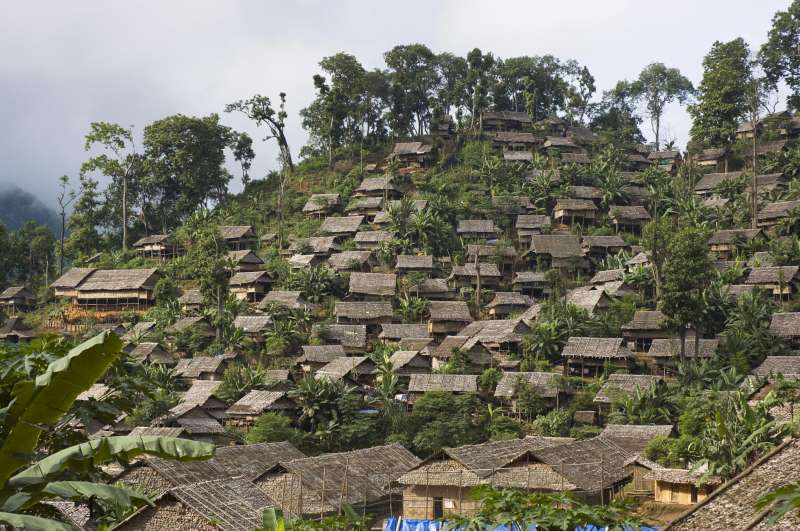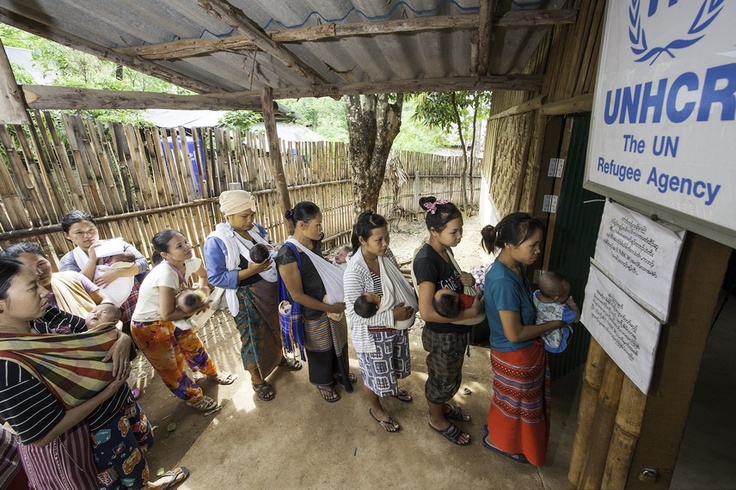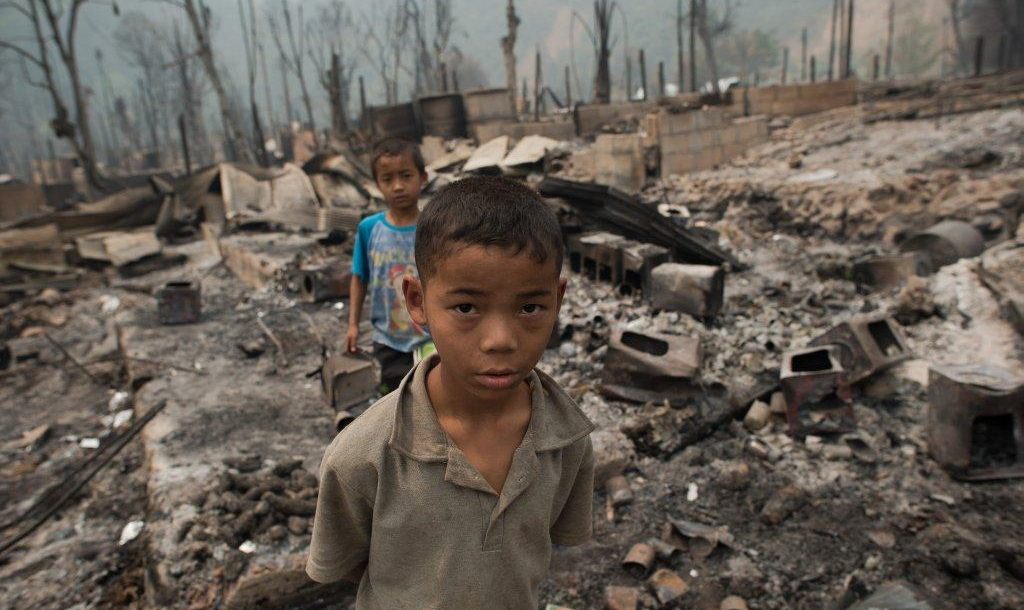For the approximately three million people from Myanmar in Thailand now, the main narrative on migration is essentially binary. The argument generally goes that one is either a labourer or one is a refugee. In terms of causation, the former is enticed to move for “voluntary” reasons of economic want, while the latter is propelled for “forced” reasons of political exigency.
This is, perhaps, something of a simplification of the research of others, but the deeper one delves into the literature of at least three specific areas or disciplines of study–contemporary migration policy analysis, international refugee and labour law, and any humanitarian or NGO-type study–the more one realises that this refugee-vs-labourer binary is the essential theoretical framework for analysis. I worry that this is more of a trope than something backed by on-the-ground evidence.
Last year Adam Saltsman made an argument in The Diplomat that too much of a differentiation between refugees and labourers may actually do harm to those who analysts and scholars may wish to help, now that so many of the once “refugees” have already entered the labour pool in Thailand. He argues that “advocacy for refugees must be linked with advocacy for migrants and for labour rights” in order to come to any “durable solutions.”
My own forays into the study of the Burmese in Thailand have also generated qualitative as well as quantitative evidence to argue against this simple binary. This needs to be analysed more fully.
One way to critique any simple causation narrative between refugees and labourers from Myanmar may be to think of it beyond the contemporary. If, as a corollary to recent data from the Thailand-Myanmar border, one were to also study the question over time, I suspect that some aspects of the binary narrative would begin to appear theoretically provincial, while other aspects would come into sharper relief. Past migrations into the space that is the Chao Phraya basin (central Thailand) may be more similar to the contemporary migration from Myanmar than originally thought.
Taking a long view, not just off the past 50 years or past century, but all the way back to at least the beginning of the Common Era, a study of a full two millennia of human mobility into and out of the entire Chao Phraya watershed tells us a very different story to the somewhat myopic, though of course always heartfelt, lived experiences of particular individuals who make the trek from Myanmar to Thailand today.
Millennia of massive movements
The Chao Phraya basin has been witness to massive movements of humans for thousands of years, which by the first quarter of the 1900s at least was still going strong. Elements of these massive movements of people still impinge upon the collective conscious of Thai subjects, most readily in terms of how they view their own migration and in terms of how they view the migrations of the “other”–in this case the Burmese–into their political society today.
Understanding the history of all migrations into the Thai political sphere for the last two thousand years is a tall order. My attempts to do so are now open for review and comment. This synthesis of two thousand years of migratory instances and patterns from incredibly rich narratives of historians into one chapter-length argument is in its first draft and is entitled “Analytic History of Migration into Thailand: Prehistory to 1917.”
Two main themes emerge when one attempts such a study. And for both of these themes, neither depend upon any supposed cleavage between migrant “refugees” and migrant “labourers” nor upon any implied cleavage between migrations that are “voluntary” and migrations that are “forced.”
Instead, from the causal view of the long-term, two general patterns emerge: 1) high-volume, short-timespan migrations; and 2) low-volume, long-timespan migrations.
The first type of high-volume, short-timespan migrations are caused by a rejection of, or capture by, a warring political society. These are best shown through the movements of Northern Tai-speakers, Mon-speakers, Lao-speakers, and Karrenic-speakers. The coerciveness as well as any perceived violent-political threat of the village-state, whether intentional or simply due to incompetence, is the self-evident cause of the majority of migrations in one way or another for the period between the 1200s and 1917. More people have moved to the Chao Phraya basin because of war, or fear thereof, than any other reason.
To provide one example out of many of this first type: any of the numerous Burmese-Siamese wars between 1547 and 1812 always included the migration of tens-of-thousands to hundreds-of-thousands of civilians and soldiers marching upon or fleeing from some raided polity. This would also have included thousands of slaves, often previously captured by military strike, being migrated by force back to one victor or another.
Sometimes the victor would be those Burmese village-states located along the Irrawaddy or Salween rivers, and other times it would be those Thai village-states located along the Chao Phraya. Additionally, any of the numerous raids between one of the Thai valley polities and an uphill community, like the Karen for example, would also have caused a population transfer under the harsh conditions of a battle won or lost.
Sometimes these migrants would have voluntarily made a choice to reject the village-state, climbing ever higher into the mountains. Other times these migrants would have simply been forced to move to serve the village-state for paddy field productions or in future internecine warfare.
The second type of low-volume, long-timespan migrations are caused by economic and material want, which the village-state can provide for some. These are best shown through the movements of Teochew-speakers, Hakka-speakers, Hainanese-speakers, Cantonese-speakers, and Hokkien-speakers. For nearly every right or advantage of material or economic worth that the village-state withheld from Northern Tai-speakers, Mon-speakers, Lao-speakers, and Karrenic-speakers, the Thai village-state opened up to Chinese-speakers to various degrees between the 1600s and 1917.
Unlike the migrations of slave capture or forced war-resettlement, these “overseas” Chinese migrations were always distinct instances of mobility, the density of which were never greater than the cargo or steerage hold on any particular seagoing vessel.
Sometimes these migrants took action and voluntarily made the move. Other times the structure of circumstances of time and space left little room for choice. Either way, the specific historical events that would have affected the changing, year-to-year relative magnitude of Chinese migration, from the point of view of two thousand years of history become less important.
Beside changes in technology and the development of better marketing of migration opportunities for those in China, there would also have been changes in attitude on how much “coolie” labor should be let in, how they should or should not be taxed, their rights as compared to the Thais normally to be found working the paddy fields, and so on.

A camp for ethnic Karen in Thailand. Photo: UNHCR
Discrete individuals, discrete causes
At the micro-level of the lived experience of any particular migrant, we may be tempted to view the “causes” as even more discrete, more particular–more individual. The examples are nearly boundless.
Some Chinese peasants’ relatives die and the dependents are free to move. Some local mandarin loses his position to a rival and seeks opportunity overseas. A Chinese farmer has his land stolen through corruption and has nowhere else to turn. Some Chinese farmer’s wife sees that the neighbour, whose husband went abroad, sends more money home and annoys her man to seek employment in the rice mills of Siam. An able-bodied youth is provided a loan to travel to work on a new railroad from Bangkok to Ayutthaya. A Chinese girl is sold to a brothel for delivery in downtown Bangkok. Some Chinese merchant hears about the liberalisation-by-force Bowring Treaty of 1855 and sets up a middleman-type comprador business house on a Chao Phraya delta port. And on and on.
The particular, individual inspirations of causation may seem infinite. However, the underlying, slow-moving, ever-petulant causal effect over the longue durée of economic want–though always individualistic, always uniquely personal from the perspective of the specific sad soul seeking some better life–would still have been something that was a fundamentally societal-level movement. The general causal process would have been played out over and over again.
As for the Tai-speakers–the more politically, materially, and martially astute of which would eventually be termed “Thai” with an “h”–these speakers, so it would seem, fell on both sides of this understanding of human mobility causation. From the 600s to the 1200s, when different Thai village-states began to exert power and influence through much of the Chao Phraya basin, an argument can be made for both sides.
For some contemporary Thais, when they consider their own history of migration into the Chao Phraya watershed, some imagine it as a conquest, others as a flight from mainland China, others still somewhere in-between these. Historically speaking, this particular migration may have simply been both: at times of exigency more high-volume, short-timespan and at other periods of freer trade more low-volume, long-timespan.
Many more details and specific examples could bolster the sides of both causation types of migration: much more could also be sad about Khmer-speakers, Hmong-speakers, Ahka-speakers, Viet-speakers, Malay-speakers, and others, beyond that of the more pointed examples above of Northern Tai-speakers, Mon-speakers, Karrenic-speakers, Lao-speakers, and Chinese-speakers briefly citied above that moved across the Chao Phraya valley at one time or another.

Mothers stand with their new born babies to register them at the Birth Registration Office of UNHCR inside the Mae La refugee camp in Mae Sot near the Thai-Myanmar border. Photo: UN Photo/Kibae Park
The contemporary realities of historical legacies
Such a history seems to have an impact on the daily lives of Burmese migrants in two primary ways. The first is in terms of very broad and very deep sociocultural and politico-economical structural moorings that, though similar to the majority of those people in mainland Southeast Asia today, are dealt with on an almost unconscious level by contemporary actors in different ways.
The second way the pre-war period is important is what is remembered of that period–that is, on the conscious and hence more easily observable level, what do actors remember about that period as highlighted by historians? This is important particularly with the Thais and how they view their own, almost mythologised history of migration into the region. The way the Thais view themselves and the notion of migration itself has a causal effect on how they view and treat contemporary Burmese in Thailand.
The argument here is that the complexities of causation for why Burmese migrants move across the border into Thailand today are constituted and ultimately grounded in a history that is much deeper than the lived experience of any set of contemporary migrants. It is also much deeper than any one individual. No matter how strongly any particular individual migrant may argue for one’s own history of victimhood as being something fundamentally unique, a healthy dose of any methodology that prizes the patterns of centuries over the feelings of an instance quickly sweeps away this uniqueness.
Any narrative that focuses on whether the migrant from Myanmar was “forced” or came “voluntarily”–whether the migrant is a “refugee” or “labourer”–misses the point entirely. In terms of enhancing governmental migration policy, international refugee and labour law, and humanitarian relief, the above binary narrative is nothing more than a quick ethical fix.
When we study the causes that proceed and ultimately constitute human mobility with a deaf, though honest, heart to those two millennia of victims moving into and out of the Chao Phraya basin, empirics argue that the politics of exigency and the economics of want are inextricably bound together. The danger is that, if we continue to view every new instance of migration as something fundamentally new to be studied in order to provide some sense of self-respect or empowerment or faux solidarity to the next victim involved, we are only blinding ourselves to the relevant facts in order to sleep better for one more night.
Whatever the solution, if there is one, it would have to tackle both ends of the narrative at the same time and understand that mobility is simply a universal for our species–something which the pathology of ten thousand years of agrarian-settled civilisation has caused us to lose sight of.
Migration histories spanning thousands of years by demographically inclined political scientists may be something of a rarity, so readers are urged to visit the document while this argument is in its initial draft form and offer constructive criticism.
TF Rhoden is a graduate student at Northern Illinois University.
 Facebook
Facebook  Twitter
Twitter  Soundcloud
Soundcloud  Youtube
Youtube  Rss
Rss 